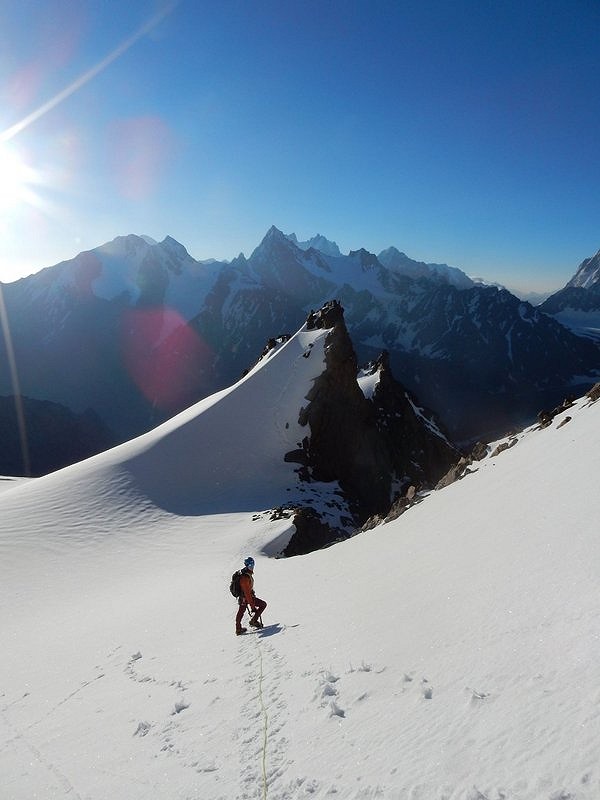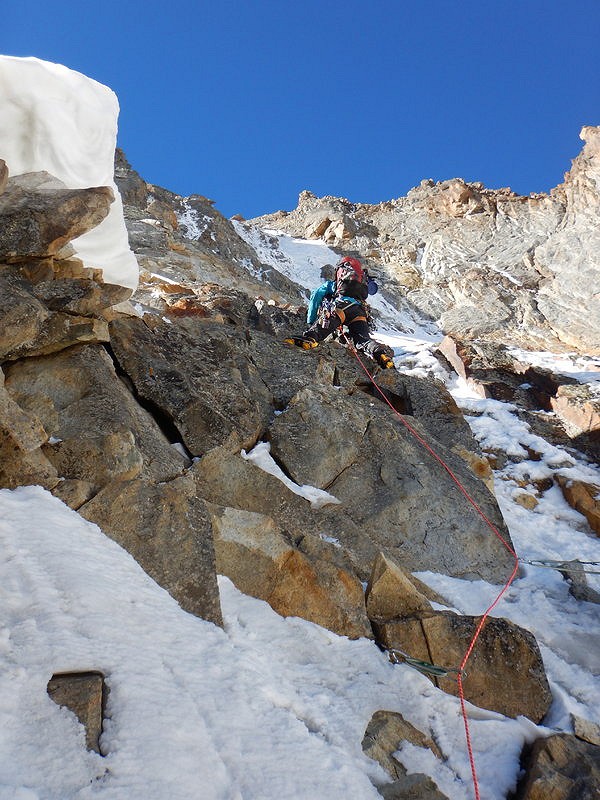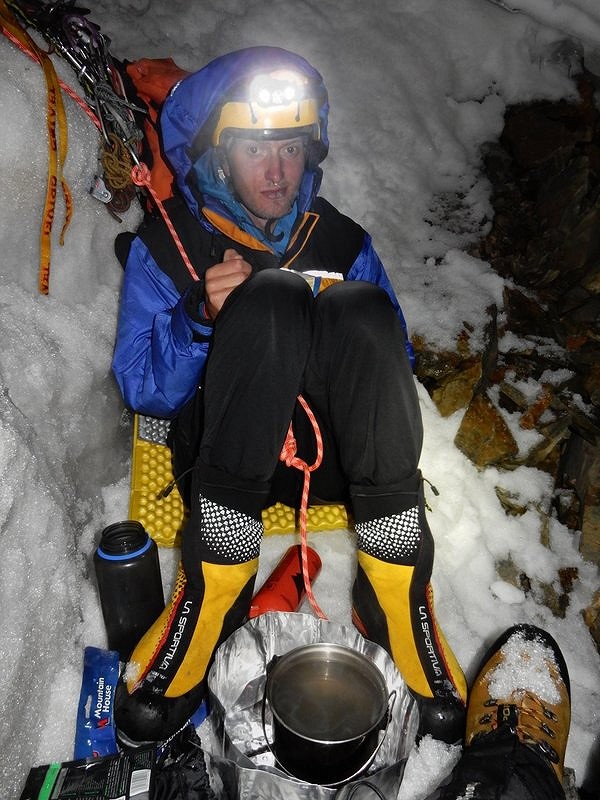
In July of this year, Robert Taylor, John Proctor, Ciaran Mullan and Phil Dawson headed to the Jiptik valley in Southeast Kyrgyzstan. Their objectives were the unclimbed north side of Muz Tok, a 5000m peak lying at the head of the valley and some potential lines on the surrounding mountains.
A remote valley, tucked away in a dusty corner of central Asia. Scenery reminiscent of the Swiss Val Ferret, unclimbed five thousand meter peaks and at it’s head a pyramid of ice, snow and granite. Quiet, waiting, day and night, freeze and thaw, waiting…
For us?
My three team mates arrived at our base camp at the head of the valley five days before me; I had intended to walk in with them but was delayed by lost baggage. Once comfortably camped by a crude hut used by the local shepherds, they got to work acclimatising to a col at 4,700m with views over a glacial cirque we believe no-one has entered.
The walk in merits a few lines to itself. From the isolated village of Zary jhas (little more than half a dozen two-room breezeblock dwellings perched amidst pasture two hours drive above the main road) a path snakes up to a col; from here the going is dusty, hot and steep. The path winds down into the valley until it meets the Karavishin river. Here there are isolated groves of apricot trees, unexpectedly green in the brown and white glare of the valley sides. An ancient looking wooden bridge crosses the river to where the path, almost invisible unless you know the way, cuts up the hillside to the next col. Down in the valley the ground is dust, rubble and scree; higher up on the next ridge it gave way to earthy shale and more greenery. My donkey driver Talik and I stopped to eat where a spring of cool water oozed from a cliff.

From the spring another hour brings the path to the ridge where it becomes a lot fainter. The route goes left and follows the crest for a while before dropping down the other side into the Jiptik valley. From here it’s a relatively straightforward walk up the valley amidst superb scenery. In total, two long days of walking.
I arrived to find basecamp empty; my friends were off acclimatising. The next day I embarked on an acclimatisation foray of my own, reaching a col at 4100m and I returned to find the others were back. They were well acclimatised by now and ready to have a crack at Muz Tok.
Two days later John, Ciaran and Phil walked in to bivvy at the base and wait for the right conditions. I used this time to climb to 4700m, 200m short of the summit of Kara-eet in order to finish my acclimatisation.
My teammates returned from their bivvy the following morning; it had been far too warm to consider getting on the face. We had a rest day then I accompanied them back to the bivvy site (this was to become a familiar walk!). We had plans for the next day; if conditions were good they would attempt Muz Tok as a three and I would go in search of a safe (i.e. non glaciated) soloing objective, if conditions were bad we would split into two teams of two and climb the soviet-era route up Muz Tok from the west. Just as we had packed our things and were about to set off it began to rain. We crammed into my two man bivvy tent and watched as the rain grew heavier and heavier. Disheartened, we walked back down the glacier to get more food and dry our things.
We decided on a change of tactics in order to maximise our chances of setting foot on the north face. John and I walked in to the bivvy spot, planning on staying one night and returning down the glacier if conditions were not right the next day. Meanwhile Ciaran and Phil would walk in the next day to the bivvy spot and replace us, ensuring there would always be one rested, well-fed pair ready to make an attempt should conditions improve.
John and I woke just before midnight to a star-filled sky and crisp air. We packed in near silence, I tied into a rope for the first time in months and we started up towards the face.
We lost some time avoiding crevasse fields and reached the bottom of the face in two hours. John led off up the initial slope. Then the rope came tight on my chest and I started kicking in.
We simul-climbed for a long time. Speed was of the essence on this part of the mountain; we had to be past the bottleneck before daylight hit the top of the face or we would be in the firing line should anything come down. We managed this and began a rising rightwards traverse, aiming for the one spot where we would be able to cross a large rock rib to reach the gully system that we hoped would lead to the summit. Our knowledge of the face so far came from our own inspection and a few grainy black and white photos; as far as we are aware nobody else had tried it.
We hit the traverse first time. Once we were out from below the rock rib I could see in the growing light the gully snaking away above us, pitches of steep ice already visible against the dark granite.

From here the climbing became more technical and we switched to pitching. There was a long section of poorly protected, scrappy climbing, crampon points hooked in thin cracks and picks on upsettingly rounded holds (once the cruddy ice had been knocked off). Two pitches of this found us at the first snowfield, a feature we had spotted from across the valley. This changed to hard ice with a thin coating of snow by its top and we traversed right from a solid rock belay to enter the fatter looking rightmost of the twin ice runnels. The sun was now playing across the face and we could feel the temperature rising. John belayed from two screws as I set off up the first icefall, finding to my dismay a pitch that refused to take an ice screw more than half way. It gave fast climbing but it felt insecure and a fall would have been bad news. I moved left and belayed on rock. John was half way up the pitch when I heard a sound above me. I didn’t need to look up.
“INCOMING!”
Ice chunks rained down; one caught the lid of my rucksack and buckled my knees, sending me into a frightened, animal shudder. I cowered against the belay, the rope tight in my hand. When all was quiet I looked down through the crook of my arm. John was huddled over his axes. As I watched, heart in mouth, his head tilted back and he kept climbing.
He reached the belay and I breathed again.
We discussed what to do next. The ice, while quick to climb, was impossible to protect adequately and would be exposed to further bombardment from above. I re-racked the gear for rock climbing and started up the granite rib.
My crampons stayed on as the occasional move required kicking into ice or snow, for holds I used about half and half hands and axes, a weird hybrid style that had more in common with Scottish mixed than summer rock. The protection improved but we slowed down dramatically. I lost count of the pitches that followed; after a while they became a blur. I finished my water. My picks, razor sharp at the base of the route, were now primary-school safe. After an eternity we reached the top of the rib and stopped for a quick power nap; ten minutes or so perched on bookshelf-sized ledges.
Another snowfield and now the day was dragging on. At the top of this there was a steepening but we could see the feature we had dubbed ‘the cornice’. There, we hoped, there would be some horizontal ground. Then rest, sleep, water…
The ground before the cornice was scrappy; loose rock, thin ice and poor prospects of protection. Then there was a pitch of steeper, thin ice, protected by screws that were barely psychological. I reached the top of that pitch, threw a sling round a huge block and gulped down the sick rising in my throat. As John passed me and took over the lead to the cornice the sun set and the temperature plummeted; my sweat grew chill on me and I threw on a belay jacket.
John brought me up. My heart sank.
The cornice was a knife-edge ridge of soft, treacherous snow. There was no chance of pitching the tent here; the only horizontal space was about as wide as a good sized desk and twice as long. I was up for continuing further but John talked me out of it (very wisely, it turned out). We spun in screws to the thankfully solid ice and began to brew up. We had been on the go for twenty two hours.
One rehydrated meal each and as much melted snow as we could stomach later we settled down for one hour of sleep. John wrapped himself in the tent fabric and I threw our sleeping bag over myself. I was woken by my legs violently cramping and had to stretch them over John’s face and chest. Then our alarms went and it was back to work. John led off on steep, unconsolidated nightmare snow, the kind of thing Patagonian climbers describe but till now I’d never experienced. Climbing this was a laborious process, balancing between collapsing bucket holds with arms sunk to the shoulder for stability. I was glad that those pitches were not mine. I dragged myself over one more loose lump to find John waist belaying me on a ridge leading to a rock wall.
The rock was dark, smooth and sloping. There were some thin cracks and the odd flat edge. I set off up, leaving my pack hanging on an unpleasantly loose ice screw. I placed a decent cam and began to relax into the climbing, gaining a few inches here and there, placing a good nut and hanging on it for a rest.
Then I couldn’t get any further. I’d exhausted my free climbing so I switched to mixed, battering my picks into thin cracks and yarding on them, crampon points slipping on the loose, shiny stuff below. It wasn’t granite; that was clear. I lowered off and swapped ends with John. He reached my high point and managed to wiggle in another nut off to the side, gaining another foot perhaps before he too backed off.
We swapped ends once more. I sorted the rack on my harness, long slings at the front for an attempt at aiding it. I reached John’s high point and hung there as I clipped a sling into the nut and worked my boot into it. I stood up, one hand on the quickdraw to support myself, the other searching above for anything, anything at all. I found a crack and forced my pick in using the flat of my hand. I clipped my longest sling to the pommell, tied a knot at knee level and, one hand on the axe, stood up in this.
Then there was nothing.
I couldn’t see a way past. All around were slopers, loose blocks, cracks that wouldn’t take a piton. I tried everything. I reached up and placed a brass offset above my axe, clipping in to this to give myself a degree of protection should my pick blow. A dreaded certainty settled on me.
‘John, I don’t think we can get up this.’
I should explain here that our descent plan had been to reverse the Soviet era route from the summit via the west ridge. Our failure to reach this put us at about 5000m with a lot of tricky climbing below us and no clear way down.

I lowered off the offset, braced for a fall at any moment as I stripped the rest of the gear. We had a quick chat about what to do next then John set off with the unenviable task of reversing the climb to the bivouac. We reached this just as day was breaking. I made an Abalakov thread and we abseiled off the other side of the ridge on which we had bivouacked – down the north west face rather than the north face. Another abseil off a large block brought us to easier ground and we began downclimbing. This soon turned into ice and then into steeper ice. John went first, placing screws before and after any harder sections. We stopped at a two screw belay just before the route we were following cliffed out. Two further abseils from dubious anchors found us still high on the Northwest face of the mountain but on a huge, straightforward ice slope. Stones were pinging around us now, some of them a good size and speed was of the essence; we stashed the ropes in our packs and set off towards the bergschrund.
Seeing where the stonefall was worst and reasoning that an extinction-event from the still in-shadow serac was far less likely than being brained by a rock, I worked my way down and left. I was perhaps 200m from the bergschrund when the sun hit the face, turning what had been reasonably frozen snow over hard ice into a skittery mush. I climbed down as quickly as I could, reached the bergschrund and tried to downclimb on top of a debris cone. This collapsed as my crampon weighted it, leaving me hanging by my tools which promptly ripped, sending me arse over head towards the glacier. When I righted myself I found that I was unharmed and on easy ground.
A rock slapping into the slush nearby reminded me that I still couldn’t relax. I plunge-stepped away till I reached unblemished snow and turned round. John was still worryingly high on the face and the whole thing was shining with sunlight and slushy snow. I knew he was in for a grim down climb but all I could do to help would be to wait till he was lower then direct him towards the best spot for crossing the bergschrund; the same spot I had used. I threw my pack down and slumped on my foam mat. I dropped off straight away, coming round every so often and checking on John’s progress. Finally he reached the bergschrund and I watched as he jumped, tearing the anti-balling plate from his crampon as he landed then skidding down the glacier before he managed to self-arrest.
He came towards me and I felt a huge surge of relief; a fall on that huge slope would have ended in a ragged, bleeding cartwheel.
‘Where are Phil and Ciaran?’
John had seen the rope and rucksack lying in the snow next to me and in his dehydrated, exhausted state had mistaken them for our friends!
‘Rob, at that last abseil I felt there was another person having that discussion with us.’
There hadn’t been; I’d have noticed. If John’s physicist’s brain was rational enough to realise that he was experiencing third man syndrome then he couldn’t be too far gone, though he did admit to being confused about what country he was in. Perhaps it was the adrenaline of having to jump the bergschrund or the long downclimb in the sun but he was obviously suffering a fair bit. I wasn’t immune; I’d been hearing strains of music for the last few hours and there was a sound like buses full of screaming school-kids that grew louder and louder. We roped up and crossed the glacier, finding an easy route in the daylight. After collecting our walking poles and spare food from the bivvy spot we began the long trudge down the rock-strewn glacier. It started to rain, lightly at first then harder and harder till we reached base camp, raindrops battering our hoods and mingling with the screaming in my ears.
Ciaran repeated my acclimatisation trip to near the summit or Kara-eet and then it was time to leave.
There’s not much to say about the rest of the trip. There’s loads, obviously; days of novel experiences and a lot of eating, but that's not for this article.
We paid a few pennies to have ourselves weighed at the bazaar in Osh. The four of us lost a total of 21kg; results that any diet product could be proud of.
Muz Tok’s north face remains unclimbed. To anyone considering having a go at the route; you know a lot more about it than we did. John and I agreed that the route would have fatter ice and lower risk of rockfall earlier in the season. Being able to place good screws and follow the ice throughout instead of using the rock rib would speed up the climbing considerably. The bivouac spot, while cramped, was safe. The wall above might succumb to a stronger, less tired climber or more aid tactics, probably on small cams or more pitons. What comes after that is anyone’s guess; but since according to the GPS our highpoint was just 95 vertical metres from the summit an ascent does seem eminently feasible…
If you do go and do it, can I have my offset and quickdraw back?
John, Ciaran, Robert and Phil would like to thank the following organisations; Mount Everest Foundation, British Mountaineering Council, Austrian Alpine Club and the Chris Walker Memorial Trust. Their financial support makes expeditions like this possible.
- Read more on the expedition blog.
- TRIP REPORT: Torugart-Too, Kyrgyzstan 8 Oct, 2010



















Comments